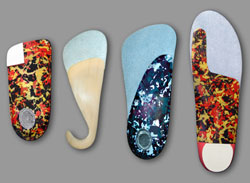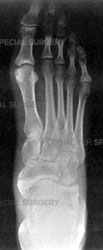Cosmetic Foot Surgery: Not Recommended
An interview with Dr. Jonathan T. Deland and Dr. Rock Positano
Fashion and comfort may not always be natural enemies, but when it comes to women's footwear, at the very least, they're often in opposite camps. That's one reason why orthopaedic surgeons and podiatrists at Hospital for Special Surgery have been watching an unusual phenomenon emerge: cosmetic surgery of the foot.
As a result of concern expressed by doctors at the Hospital for Special Surgery about the risk of an unfavorable outcome when foot surgery is performed for cosmetic reasons alone, there is a growing public awareness of this inappropriate surgery. As chronicled in an article that appeared on the front page of The New York Times, the desire to wear high-fashion designer shoes – which often have very high heels and a narrow and pointed toe – is prompting some women to ask for elective surgery. The American Orthopaedic Foot and Ankle Society and the American Podiatric Medical Association have made position statements regarding the dangers of cosmetic foot surgery.
Among those operations requested are procedures to correct the appearance of a bunion, an abnormally downward-curled lesser toe (hammertoe), shortening of a long second toe, the injection of collagen into the toes or ball of the foot to provide more padding, and removal of the baby toe. These procedures are not only inadvisable, according to Rock Positano, DPM, a podiatrist and Director of the nonsurgical Foot and Ankle Service at HSS, the results can be disastrous. "Patients who undergo these procedures may do so believing that a 20-minute operation will enable them to wear more attractive shoes, when, in fact, they may be risking twenty or more years of disabling pain."
Jonathan T. Deland, MD, who is an orthopaedic surgeon and Chief of the Foot and Ankle Service at HSS agrees. "Cosmetic surgery on a pain-free, well-functioning foot is never appropriate." As both physicians point out, the foot is a complex biomechanical structure made up of numerous bones, ligaments, and tendons designed to bear the patient's weight during walking and exercise. When this mechanism is disrupted, even with an apparently minor procedure, the patient's ability to walk comfortably may be irreparably damaged.
Because of reports in the popular media, patients who seek medical care for a painful foot or ankle may be under the misapprehension that surgery is their only option, according to Drs. Deland and Positano. In fact, many painful conditions of the foot – including those that may be caused or made worse by poorly fitting shoes – may be treated nonsurgically. Among these conservative options are:
- Physical therapy that can increase the range of motion in the joint, and decrease swelling and pain
- Prescription orthotics – molded inserts worn in the shoes – which address structural abnormalities in the foot and help redistribute load
- Ultrasound-guided cortisone injections, which allow delivery of a powerful anti-inflammatory medication in the exact area where it is needed. This treatment can also be highly effective in the treatment of problems with the Achilles tendon, and pain in the heel, toe and midfoot.
(Read more on prescription orthotics.)

Various types of prescription orthotics
When is surgical treatment of the foot the right choice? According to Dr. Deland and Dr. Positano, in otherwise healthy patients, only when conservative measures have been exhausted. In the case of bunions, if the patient experiences persistent pain and is unable to fit comfortably in any kind of footwear, or if the bunion itself is not painful, but is causing other problems such as pain in the second toe or the ball of the foot.

X-ray of normal foot

X-ray of a foot with a pronounced bunion
Similarly, hammertoes that remain painful after nonsurgical treatment and prevent the patient from fitting into shoes, can be corrected surgically. In patients who have not had previous surgical treatment, success rates for both of these procedures is about 90%, as measured by pain relief and the ability to wear shoes.
Both Dr. Deland and Dr. Positano treat patients who have had unsatisfactory results from cosmetic surgery procedures, addressing persistent problems with bunions and hammertoes, and discomfort arising from toe-shortening procedures, toe removal, and collagen injections. This group of patients may also benefit from both nonsurgical and surgical treatment, but success rates are somewhat lower.
Defenders of cosmetic foot surgery have likened the procedures to plastic surgery of the face. Both Drs. Deland and Positano disagree. "When you're dealing with the foot, we're talking about a structure you walk on, that serves a vital weight-bearing function every day. If you're going to have surgery, make sure it's for the right reasons." adds Dr. Deland.
"The poor results achieved with cosmetic foot surgery is a public health problem that arises from pressures on women to be stylish," says Dr. Positano. "We're seeing it primarily in metropolitan areas and our patients are often in the entertainment or media field, where appearance is emphasized." The important thing, he adds, is for women to understand the consequences of their choices.
"We're not telling women they can never wear high heels," says Dr. Deland. "But they should do so intelligently." As a general guideline, the physicians suggest reserving such footwear for special occasions, a shoe with a heel of no more than one inch is advised for use during the work day especially for those women who must stand for prolonged periods of time.
Both physicians have likened the current interest in cosmetic foot surgery to the temporary popularity of minimally invasive foot surgery in the 1980s. "The idea was to do procedures such as bunion correction through a few minor cuts in the foot, and by shaving down bone," says Dr. Deland. Many patients had poor results because the underlying problem was not adequately addressed. "We're seeing patients now who had these surgeries and are experiencing continued or renewed problems," adds Dr. Positano. "These problems can extend beyond pain in the foot, affecting the knee, hip, back, and even the jaw. Our hope is that with the proper education about cosmetic foot surgery, we can prevent these problems before they occur."
Updated: 12/21/2018
Summary prepared by Nancy Novick • Diagnostic imaging examinations provided by HSS RadiologistsAuthors
Director, Non-surgical Foot and Ankle Service, Hospital for Special Surgery
Clinical Assistant Professor, Weill Cornell Medical College
Attending Orthopedic Surgeon, Hospital for Special Surgery



